University Report: Big Data Advantages in E-commerce
VerifiedAdded on 2023/04/23
|46
|10825
|416
Report
AI Summary
This report critically analyzes the advantages of big data in the e-commerce business, emphasizing its role in organizational tasks and decision-making. It explores the background of big data analytics, the e-commerce business, and their relationship, highlighting the importance of business intelligence in e-commerce using big data. The research methodology includes qualitative and quantitative analysis, focusing on data collection and ethical considerations. The report examines the impact of big data on e-commerce business intelligence, opportunities, and required skills, concluding with recommendations, limitations, and future study scopes. The report provides insights into how big data can be implemented within e-commerce organizations to improve business results and employee productivity, while also considering potential threats or alternatives to big data operations. The study includes an introduction, literature review, research methodology, data analysis, and conclusion with recommendations.
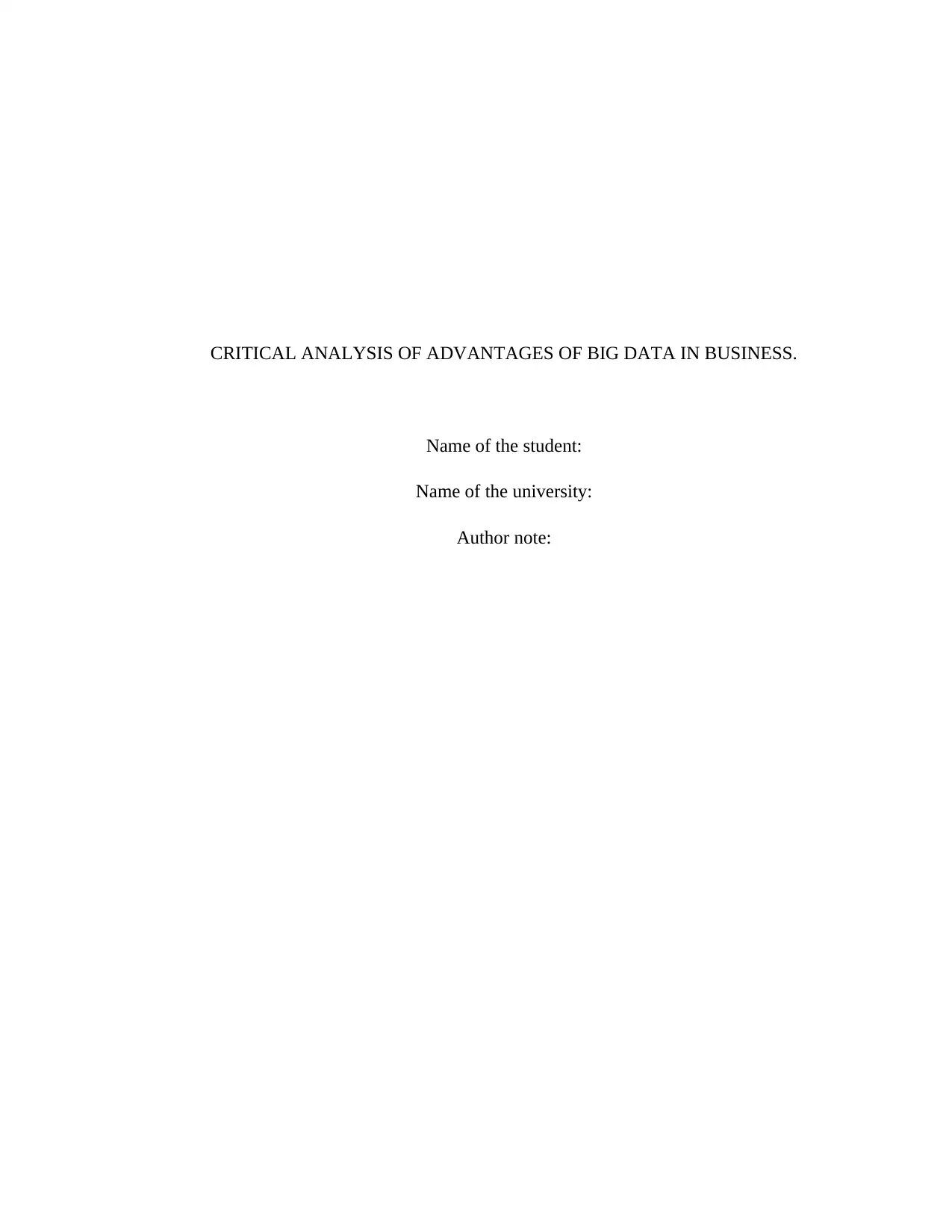
CRITICAL ANALYSIS OF ADVANTAGES OF BIG DATA IN BUSINESS.
Name of the student:
Name of the university:
Author note:
Name of the student:
Name of the university:
Author note:
Paraphrase This Document
Need a fresh take? Get an instant paraphrase of this document with our AI Paraphraser
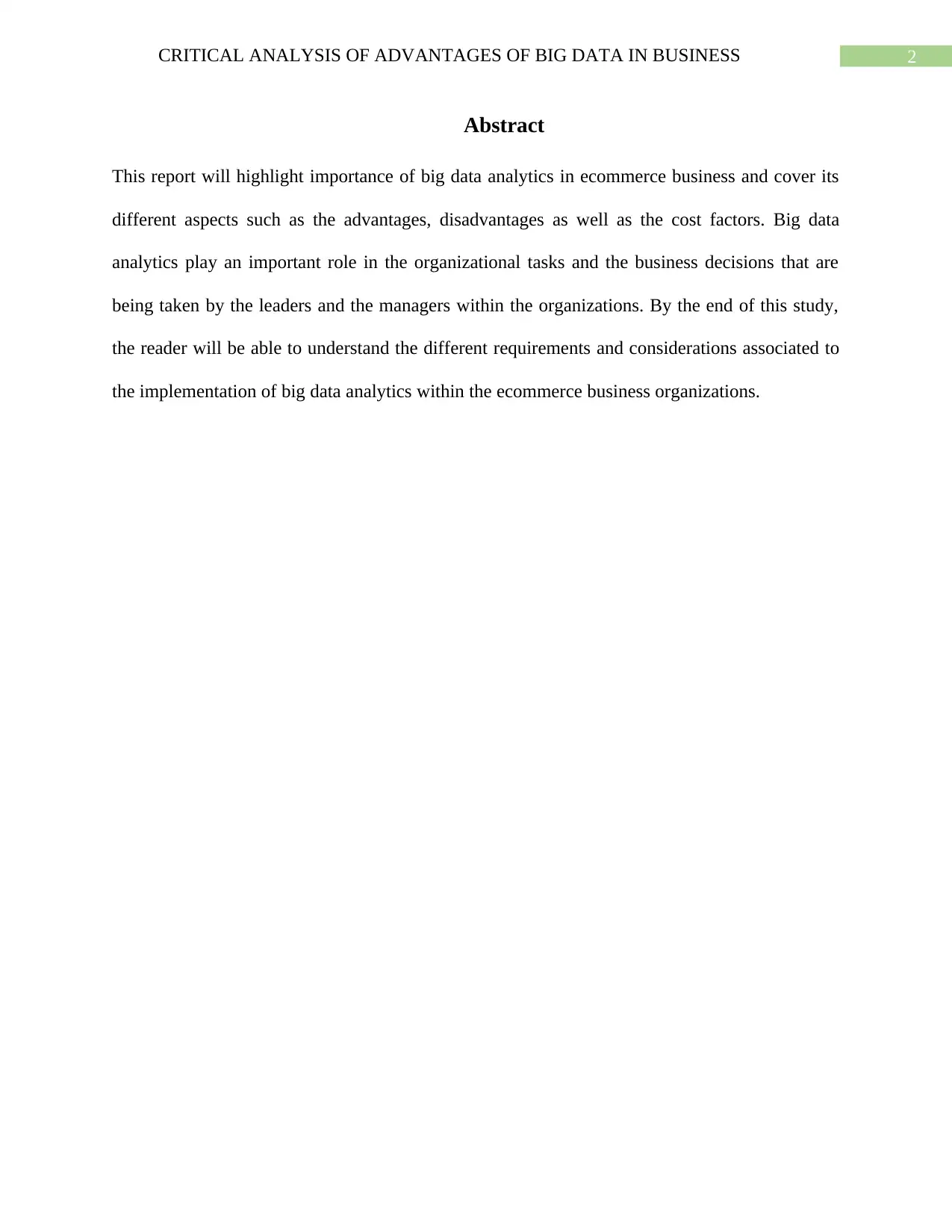
2CRITICAL ANALYSIS OF ADVANTAGES OF BIG DATA IN BUSINESS
Abstract
This report will highlight importance of big data analytics in ecommerce business and cover its
different aspects such as the advantages, disadvantages as well as the cost factors. Big data
analytics play an important role in the organizational tasks and the business decisions that are
being taken by the leaders and the managers within the organizations. By the end of this study,
the reader will be able to understand the different requirements and considerations associated to
the implementation of big data analytics within the ecommerce business organizations.
Abstract
This report will highlight importance of big data analytics in ecommerce business and cover its
different aspects such as the advantages, disadvantages as well as the cost factors. Big data
analytics play an important role in the organizational tasks and the business decisions that are
being taken by the leaders and the managers within the organizations. By the end of this study,
the reader will be able to understand the different requirements and considerations associated to
the implementation of big data analytics within the ecommerce business organizations.
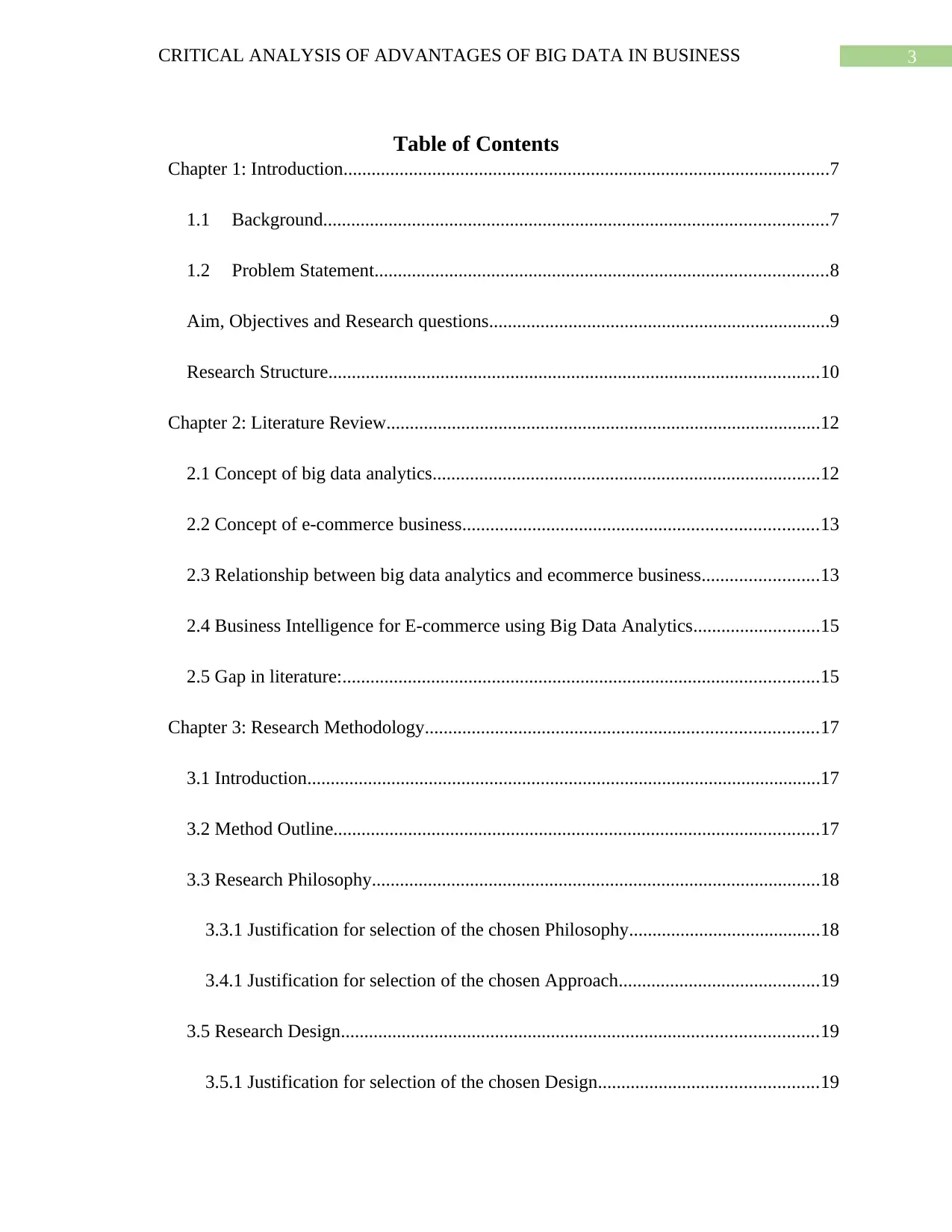
3CRITICAL ANALYSIS OF ADVANTAGES OF BIG DATA IN BUSINESS
Table of Contents
Chapter 1: Introduction........................................................................................................7
1.1 Background............................................................................................................7
1.2 Problem Statement.................................................................................................8
Aim, Objectives and Research questions.........................................................................9
Research Structure.........................................................................................................10
Chapter 2: Literature Review.............................................................................................12
2.1 Concept of big data analytics...................................................................................12
2.2 Concept of e-commerce business............................................................................13
2.3 Relationship between big data analytics and ecommerce business.........................13
2.4 Business Intelligence for E-commerce using Big Data Analytics...........................15
2.5 Gap in literature:......................................................................................................15
Chapter 3: Research Methodology....................................................................................17
3.1 Introduction..............................................................................................................17
3.2 Method Outline........................................................................................................17
3.3 Research Philosophy................................................................................................18
3.3.1 Justification for selection of the chosen Philosophy.........................................18
3.4.1 Justification for selection of the chosen Approach...........................................19
3.5 Research Design......................................................................................................19
3.5.1 Justification for selection of the chosen Design...............................................19
Table of Contents
Chapter 1: Introduction........................................................................................................7
1.1 Background............................................................................................................7
1.2 Problem Statement.................................................................................................8
Aim, Objectives and Research questions.........................................................................9
Research Structure.........................................................................................................10
Chapter 2: Literature Review.............................................................................................12
2.1 Concept of big data analytics...................................................................................12
2.2 Concept of e-commerce business............................................................................13
2.3 Relationship between big data analytics and ecommerce business.........................13
2.4 Business Intelligence for E-commerce using Big Data Analytics...........................15
2.5 Gap in literature:......................................................................................................15
Chapter 3: Research Methodology....................................................................................17
3.1 Introduction..............................................................................................................17
3.2 Method Outline........................................................................................................17
3.3 Research Philosophy................................................................................................18
3.3.1 Justification for selection of the chosen Philosophy.........................................18
3.4.1 Justification for selection of the chosen Approach...........................................19
3.5 Research Design......................................................................................................19
3.5.1 Justification for selection of the chosen Design...............................................19
⊘ This is a preview!⊘
Do you want full access?
Subscribe today to unlock all pages.

Trusted by 1+ million students worldwide
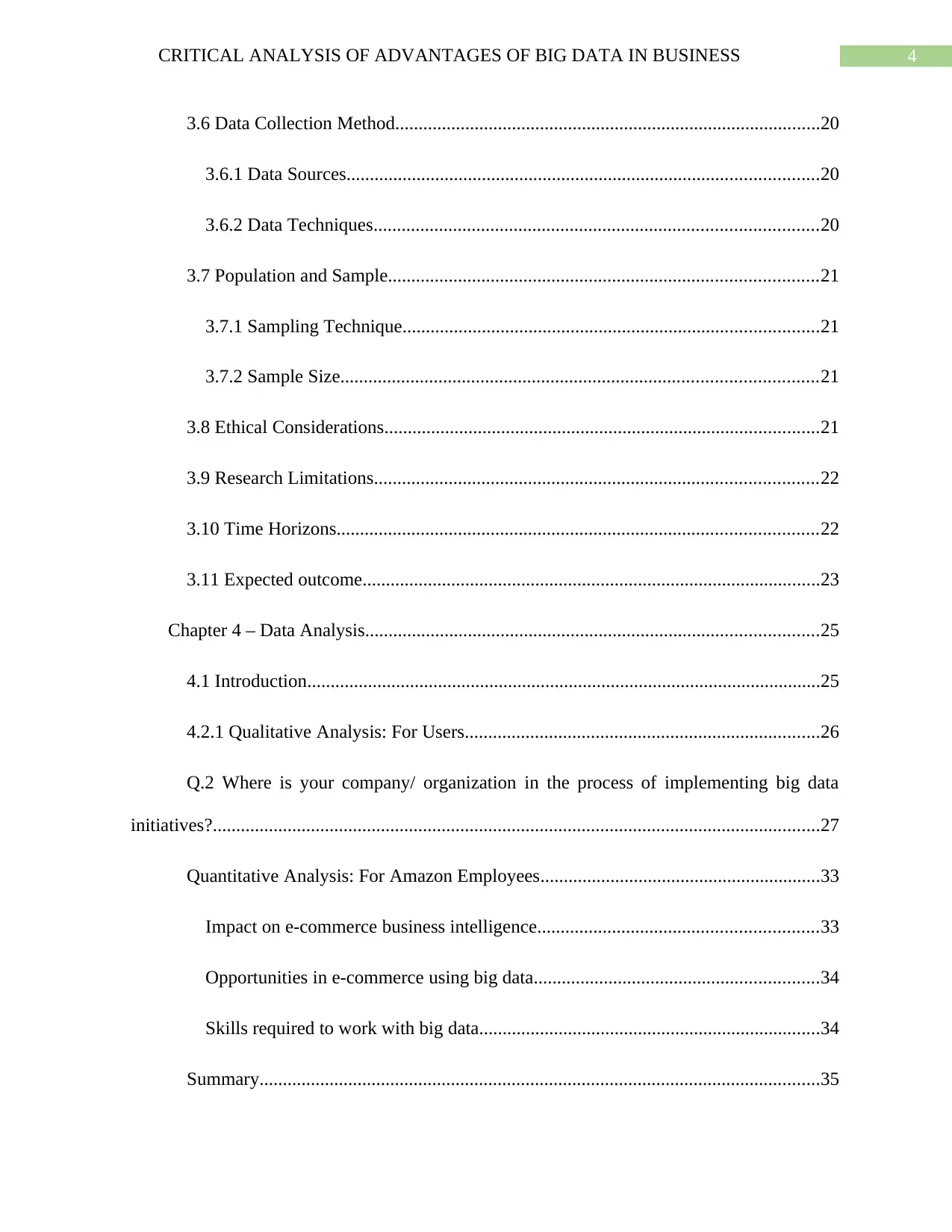
4CRITICAL ANALYSIS OF ADVANTAGES OF BIG DATA IN BUSINESS
3.6 Data Collection Method...........................................................................................20
3.6.1 Data Sources.....................................................................................................20
3.6.2 Data Techniques...............................................................................................20
3.7 Population and Sample............................................................................................21
3.7.1 Sampling Technique.........................................................................................21
3.7.2 Sample Size......................................................................................................21
3.8 Ethical Considerations.............................................................................................21
3.9 Research Limitations...............................................................................................22
3.10 Time Horizons.......................................................................................................22
3.11 Expected outcome..................................................................................................23
Chapter 4 – Data Analysis.................................................................................................25
4.1 Introduction..............................................................................................................25
4.2.1 Qualitative Analysis: For Users............................................................................26
Q.2 Where is your company/ organization in the process of implementing big data
initiatives?..................................................................................................................................27
Quantitative Analysis: For Amazon Employees............................................................33
Impact on e-commerce business intelligence............................................................33
Opportunities in e-commerce using big data.............................................................34
Skills required to work with big data.........................................................................34
Summary........................................................................................................................35
3.6 Data Collection Method...........................................................................................20
3.6.1 Data Sources.....................................................................................................20
3.6.2 Data Techniques...............................................................................................20
3.7 Population and Sample............................................................................................21
3.7.1 Sampling Technique.........................................................................................21
3.7.2 Sample Size......................................................................................................21
3.8 Ethical Considerations.............................................................................................21
3.9 Research Limitations...............................................................................................22
3.10 Time Horizons.......................................................................................................22
3.11 Expected outcome..................................................................................................23
Chapter 4 – Data Analysis.................................................................................................25
4.1 Introduction..............................................................................................................25
4.2.1 Qualitative Analysis: For Users............................................................................26
Q.2 Where is your company/ organization in the process of implementing big data
initiatives?..................................................................................................................................27
Quantitative Analysis: For Amazon Employees............................................................33
Impact on e-commerce business intelligence............................................................33
Opportunities in e-commerce using big data.............................................................34
Skills required to work with big data.........................................................................34
Summary........................................................................................................................35
Paraphrase This Document
Need a fresh take? Get an instant paraphrase of this document with our AI Paraphraser
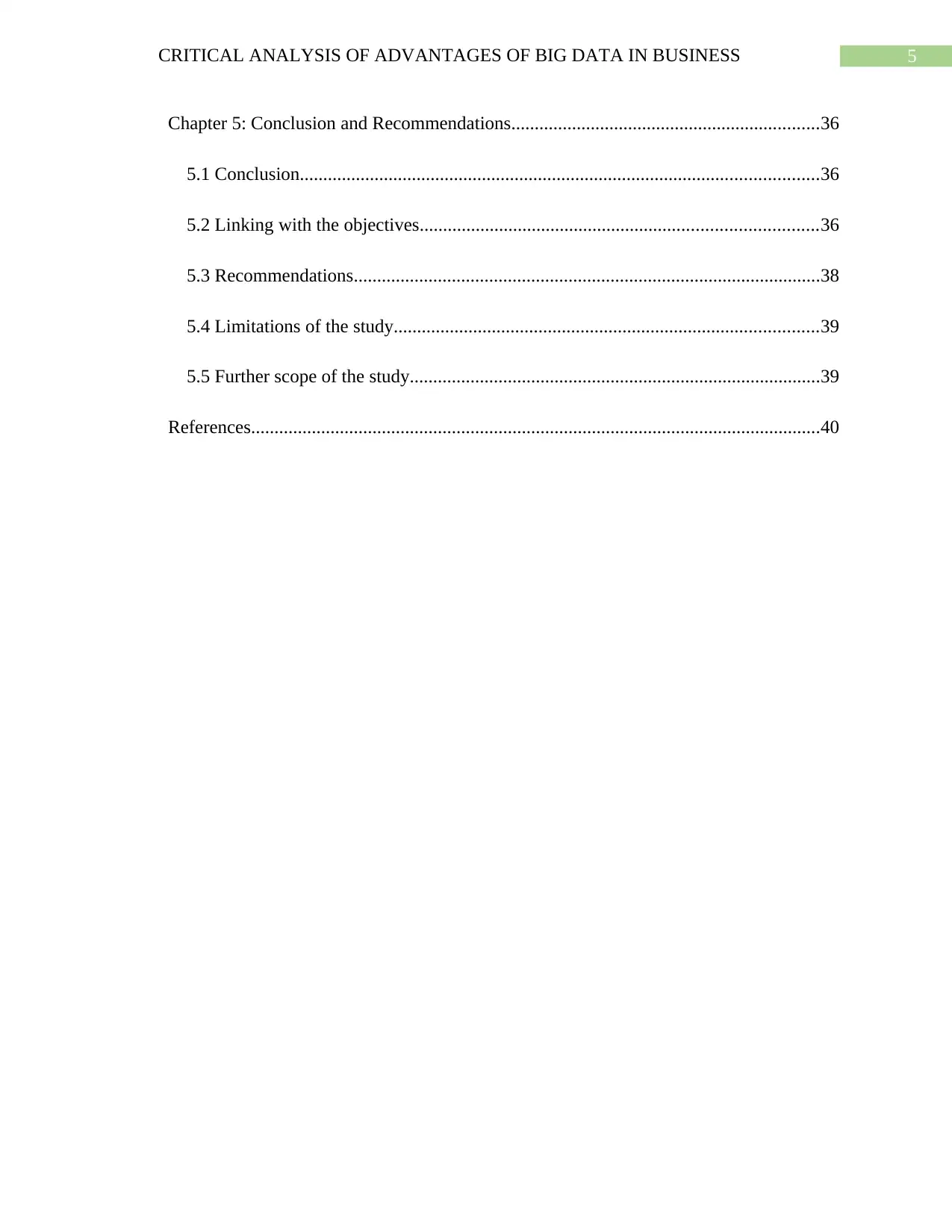
5CRITICAL ANALYSIS OF ADVANTAGES OF BIG DATA IN BUSINESS
Chapter 5: Conclusion and Recommendations..................................................................36
5.1 Conclusion...............................................................................................................36
5.2 Linking with the objectives.....................................................................................36
5.3 Recommendations....................................................................................................38
5.4 Limitations of the study...........................................................................................39
5.5 Further scope of the study........................................................................................39
References..........................................................................................................................40
Chapter 5: Conclusion and Recommendations..................................................................36
5.1 Conclusion...............................................................................................................36
5.2 Linking with the objectives.....................................................................................36
5.3 Recommendations....................................................................................................38
5.4 Limitations of the study...........................................................................................39
5.5 Further scope of the study........................................................................................39
References..........................................................................................................................40
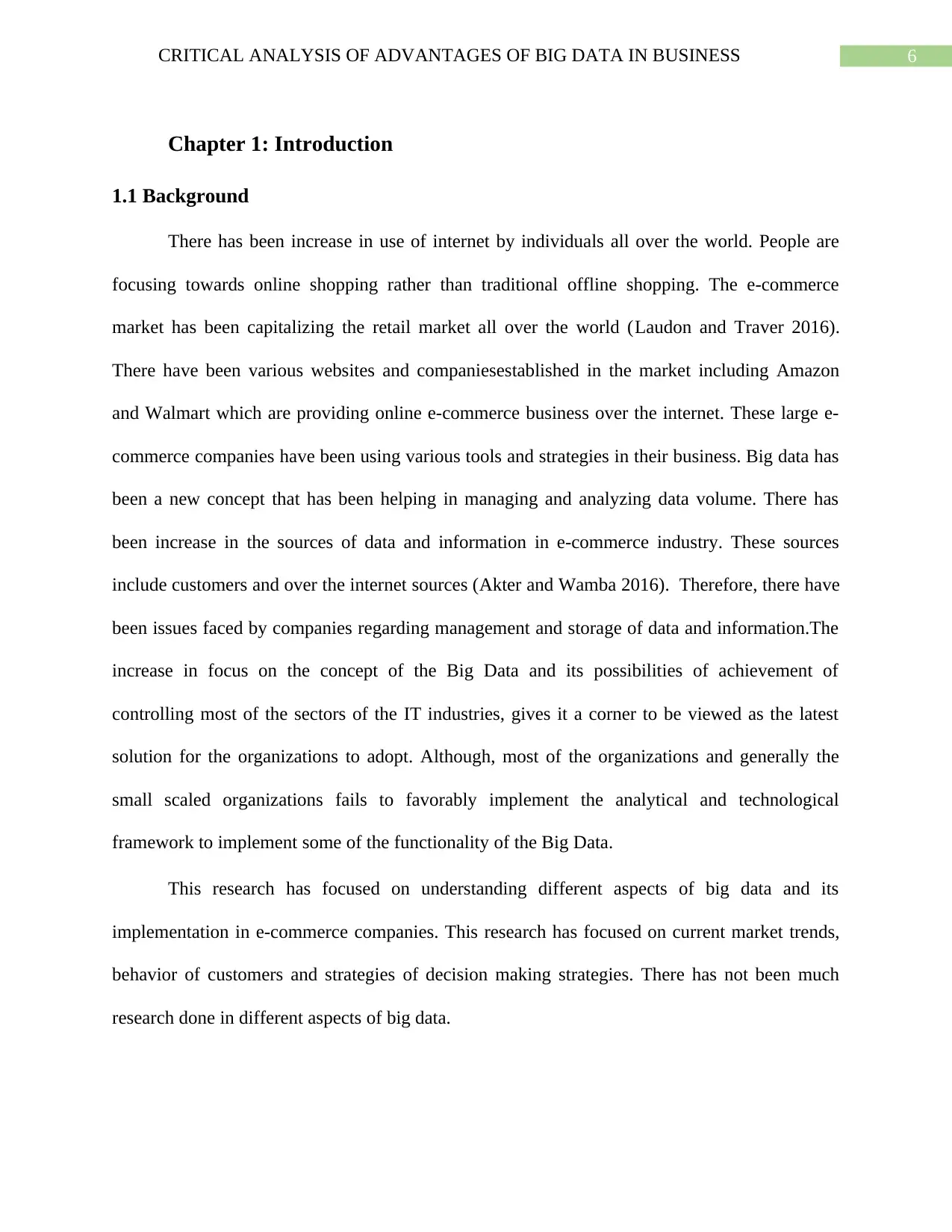
6CRITICAL ANALYSIS OF ADVANTAGES OF BIG DATA IN BUSINESS
Chapter 1: Introduction
1.1 Background
There has been increase in use of internet by individuals all over the world. People are
focusing towards online shopping rather than traditional offline shopping. The e-commerce
market has been capitalizing the retail market all over the world (Laudon and Traver 2016).
There have been various websites and companiesestablished in the market including Amazon
and Walmart which are providing online e-commerce business over the internet. These large e-
commerce companies have been using various tools and strategies in their business. Big data has
been a new concept that has been helping in managing and analyzing data volume. There has
been increase in the sources of data and information in e-commerce industry. These sources
include customers and over the internet sources (Akter and Wamba 2016). Therefore, there have
been issues faced by companies regarding management and storage of data and information.The
increase in focus on the concept of the Big Data and its possibilities of achievement of
controlling most of the sectors of the IT industries, gives it a corner to be viewed as the latest
solution for the organizations to adopt. Although, most of the organizations and generally the
small scaled organizations fails to favorably implement the analytical and technological
framework to implement some of the functionality of the Big Data.
This research has focused on understanding different aspects of big data and its
implementation in e-commerce companies. This research has focused on current market trends,
behavior of customers and strategies of decision making strategies. There has not been much
research done in different aspects of big data.
Chapter 1: Introduction
1.1 Background
There has been increase in use of internet by individuals all over the world. People are
focusing towards online shopping rather than traditional offline shopping. The e-commerce
market has been capitalizing the retail market all over the world (Laudon and Traver 2016).
There have been various websites and companiesestablished in the market including Amazon
and Walmart which are providing online e-commerce business over the internet. These large e-
commerce companies have been using various tools and strategies in their business. Big data has
been a new concept that has been helping in managing and analyzing data volume. There has
been increase in the sources of data and information in e-commerce industry. These sources
include customers and over the internet sources (Akter and Wamba 2016). Therefore, there have
been issues faced by companies regarding management and storage of data and information.The
increase in focus on the concept of the Big Data and its possibilities of achievement of
controlling most of the sectors of the IT industries, gives it a corner to be viewed as the latest
solution for the organizations to adopt. Although, most of the organizations and generally the
small scaled organizations fails to favorably implement the analytical and technological
framework to implement some of the functionality of the Big Data.
This research has focused on understanding different aspects of big data and its
implementation in e-commerce companies. This research has focused on current market trends,
behavior of customers and strategies of decision making strategies. There has not been much
research done in different aspects of big data.
⊘ This is a preview!⊘
Do you want full access?
Subscribe today to unlock all pages.

Trusted by 1+ million students worldwide
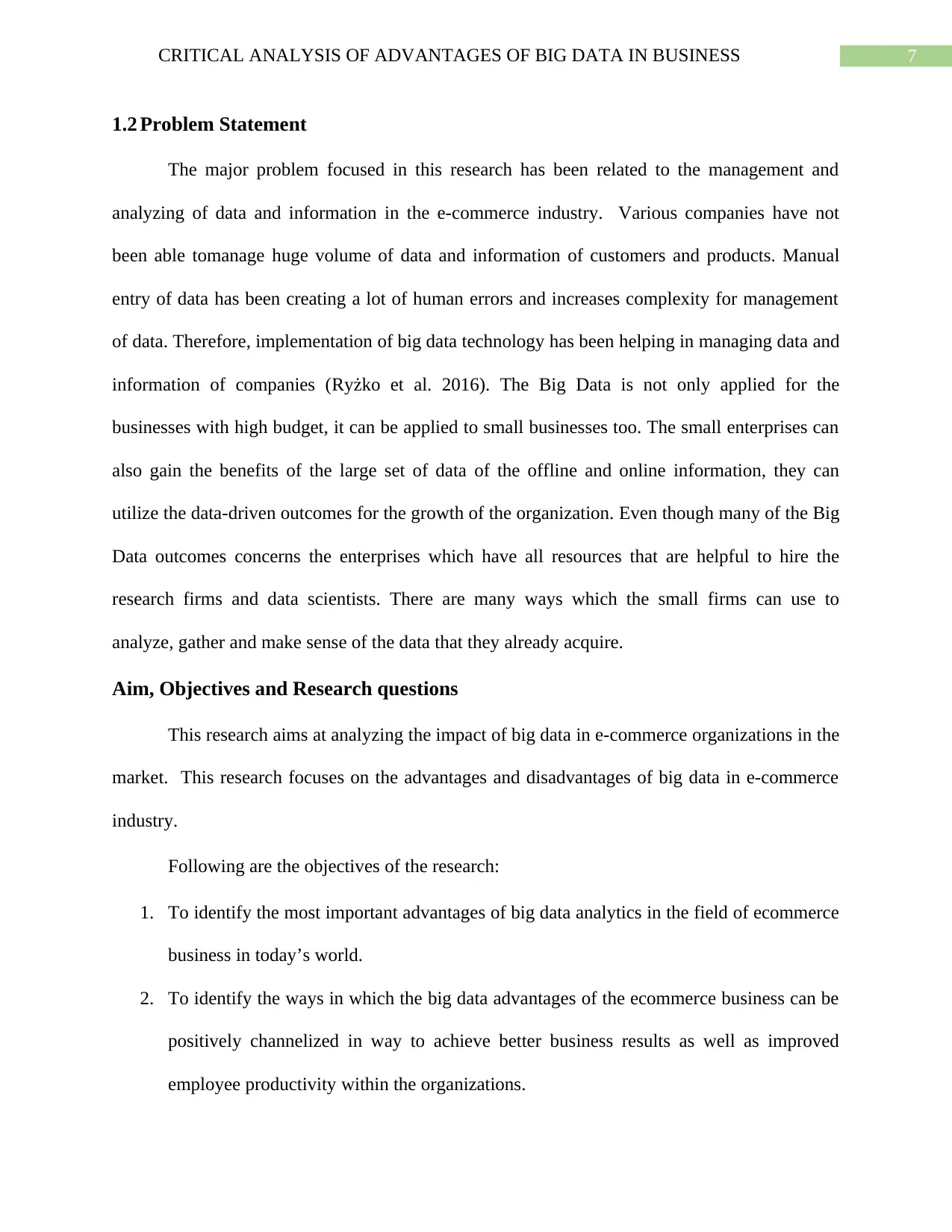
7CRITICAL ANALYSIS OF ADVANTAGES OF BIG DATA IN BUSINESS
1.2 Problem Statement
The major problem focused in this research has been related to the management and
analyzing of data and information in the e-commerce industry. Various companies have not
been able tomanage huge volume of data and information of customers and products. Manual
entry of data has been creating a lot of human errors and increases complexity for management
of data. Therefore, implementation of big data technology has been helping in managing data and
information of companies (Ryżko et al. 2016). The Big Data is not only applied for the
businesses with high budget, it can be applied to small businesses too. The small enterprises can
also gain the benefits of the large set of data of the offline and online information, they can
utilize the data-driven outcomes for the growth of the organization. Even though many of the Big
Data outcomes concerns the enterprises which have all resources that are helpful to hire the
research firms and data scientists. There are many ways which the small firms can use to
analyze, gather and make sense of the data that they already acquire.
Aim, Objectives and Research questions
This research aims at analyzing the impact of big data in e-commerce organizations in the
market. This research focuses on the advantages and disadvantages of big data in e-commerce
industry.
Following are the objectives of the research:
1. To identify the most important advantages of big data analytics in the field of ecommerce
business in today’s world.
2. To identify the ways in which the big data advantages of the ecommerce business can be
positively channelized in way to achieve better business results as well as improved
employee productivity within the organizations.
1.2 Problem Statement
The major problem focused in this research has been related to the management and
analyzing of data and information in the e-commerce industry. Various companies have not
been able tomanage huge volume of data and information of customers and products. Manual
entry of data has been creating a lot of human errors and increases complexity for management
of data. Therefore, implementation of big data technology has been helping in managing data and
information of companies (Ryżko et al. 2016). The Big Data is not only applied for the
businesses with high budget, it can be applied to small businesses too. The small enterprises can
also gain the benefits of the large set of data of the offline and online information, they can
utilize the data-driven outcomes for the growth of the organization. Even though many of the Big
Data outcomes concerns the enterprises which have all resources that are helpful to hire the
research firms and data scientists. There are many ways which the small firms can use to
analyze, gather and make sense of the data that they already acquire.
Aim, Objectives and Research questions
This research aims at analyzing the impact of big data in e-commerce organizations in the
market. This research focuses on the advantages and disadvantages of big data in e-commerce
industry.
Following are the objectives of the research:
1. To identify the most important advantages of big data analytics in the field of ecommerce
business in today’s world.
2. To identify the ways in which the big data advantages of the ecommerce business can be
positively channelized in way to achieve better business results as well as improved
employee productivity within the organizations.
Paraphrase This Document
Need a fresh take? Get an instant paraphrase of this document with our AI Paraphraser
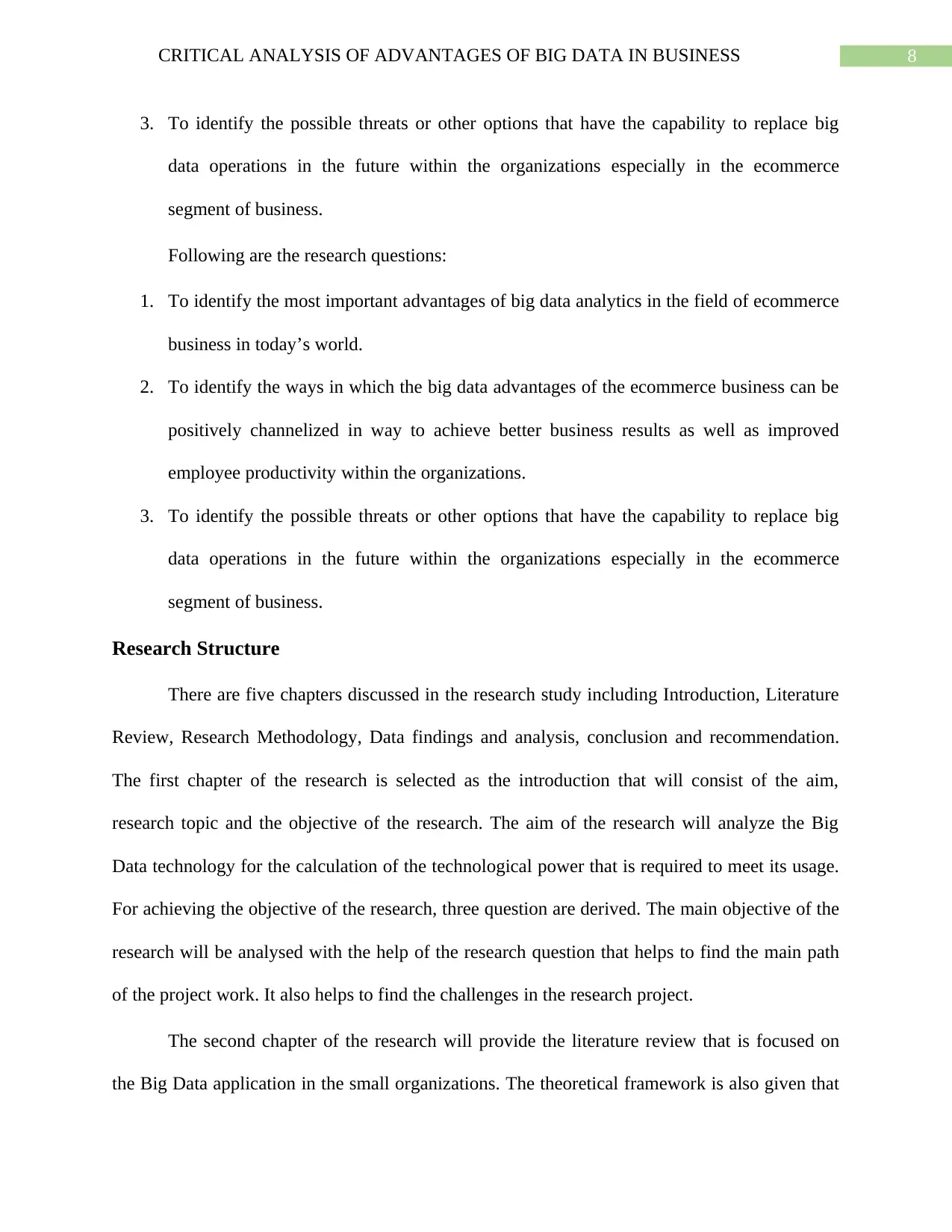
8CRITICAL ANALYSIS OF ADVANTAGES OF BIG DATA IN BUSINESS
3. To identify the possible threats or other options that have the capability to replace big
data operations in the future within the organizations especially in the ecommerce
segment of business.
Following are the research questions:
1. To identify the most important advantages of big data analytics in the field of ecommerce
business in today’s world.
2. To identify the ways in which the big data advantages of the ecommerce business can be
positively channelized in way to achieve better business results as well as improved
employee productivity within the organizations.
3. To identify the possible threats or other options that have the capability to replace big
data operations in the future within the organizations especially in the ecommerce
segment of business.
Research Structure
There are five chapters discussed in the research study including Introduction, Literature
Review, Research Methodology, Data findings and analysis, conclusion and recommendation.
The first chapter of the research is selected as the introduction that will consist of the aim,
research topic and the objective of the research. The aim of the research will analyze the Big
Data technology for the calculation of the technological power that is required to meet its usage.
For achieving the objective of the research, three question are derived. The main objective of the
research will be analysed with the help of the research question that helps to find the main path
of the project work. It also helps to find the challenges in the research project.
The second chapter of the research will provide the literature review that is focused on
the Big Data application in the small organizations. The theoretical framework is also given that
3. To identify the possible threats or other options that have the capability to replace big
data operations in the future within the organizations especially in the ecommerce
segment of business.
Following are the research questions:
1. To identify the most important advantages of big data analytics in the field of ecommerce
business in today’s world.
2. To identify the ways in which the big data advantages of the ecommerce business can be
positively channelized in way to achieve better business results as well as improved
employee productivity within the organizations.
3. To identify the possible threats or other options that have the capability to replace big
data operations in the future within the organizations especially in the ecommerce
segment of business.
Research Structure
There are five chapters discussed in the research study including Introduction, Literature
Review, Research Methodology, Data findings and analysis, conclusion and recommendation.
The first chapter of the research is selected as the introduction that will consist of the aim,
research topic and the objective of the research. The aim of the research will analyze the Big
Data technology for the calculation of the technological power that is required to meet its usage.
For achieving the objective of the research, three question are derived. The main objective of the
research will be analysed with the help of the research question that helps to find the main path
of the project work. It also helps to find the challenges in the research project.
The second chapter of the research will provide the literature review that is focused on
the Big Data application in the small organizations. The theoretical framework is also given that
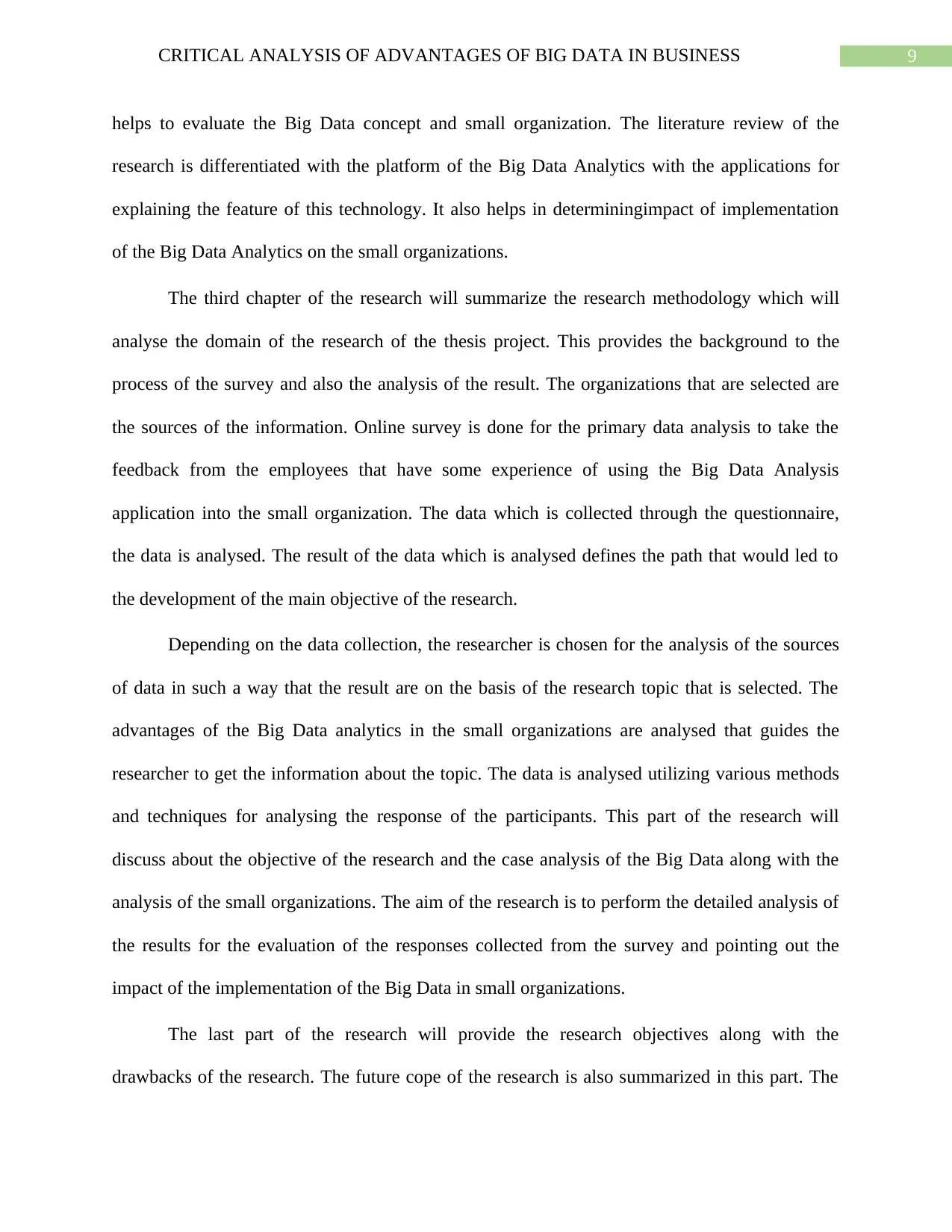
9CRITICAL ANALYSIS OF ADVANTAGES OF BIG DATA IN BUSINESS
helps to evaluate the Big Data concept and small organization. The literature review of the
research is differentiated with the platform of the Big Data Analytics with the applications for
explaining the feature of this technology. It also helps in determiningimpact of implementation
of the Big Data Analytics on the small organizations.
The third chapter of the research will summarize the research methodology which will
analyse the domain of the research of the thesis project. This provides the background to the
process of the survey and also the analysis of the result. The organizations that are selected are
the sources of the information. Online survey is done for the primary data analysis to take the
feedback from the employees that have some experience of using the Big Data Analysis
application into the small organization. The data which is collected through the questionnaire,
the data is analysed. The result of the data which is analysed defines the path that would led to
the development of the main objective of the research.
Depending on the data collection, the researcher is chosen for the analysis of the sources
of data in such a way that the result are on the basis of the research topic that is selected. The
advantages of the Big Data analytics in the small organizations are analysed that guides the
researcher to get the information about the topic. The data is analysed utilizing various methods
and techniques for analysing the response of the participants. This part of the research will
discuss about the objective of the research and the case analysis of the Big Data along with the
analysis of the small organizations. The aim of the research is to perform the detailed analysis of
the results for the evaluation of the responses collected from the survey and pointing out the
impact of the implementation of the Big Data in small organizations.
The last part of the research will provide the research objectives along with the
drawbacks of the research. The future cope of the research is also summarized in this part. The
helps to evaluate the Big Data concept and small organization. The literature review of the
research is differentiated with the platform of the Big Data Analytics with the applications for
explaining the feature of this technology. It also helps in determiningimpact of implementation
of the Big Data Analytics on the small organizations.
The third chapter of the research will summarize the research methodology which will
analyse the domain of the research of the thesis project. This provides the background to the
process of the survey and also the analysis of the result. The organizations that are selected are
the sources of the information. Online survey is done for the primary data analysis to take the
feedback from the employees that have some experience of using the Big Data Analysis
application into the small organization. The data which is collected through the questionnaire,
the data is analysed. The result of the data which is analysed defines the path that would led to
the development of the main objective of the research.
Depending on the data collection, the researcher is chosen for the analysis of the sources
of data in such a way that the result are on the basis of the research topic that is selected. The
advantages of the Big Data analytics in the small organizations are analysed that guides the
researcher to get the information about the topic. The data is analysed utilizing various methods
and techniques for analysing the response of the participants. This part of the research will
discuss about the objective of the research and the case analysis of the Big Data along with the
analysis of the small organizations. The aim of the research is to perform the detailed analysis of
the results for the evaluation of the responses collected from the survey and pointing out the
impact of the implementation of the Big Data in small organizations.
The last part of the research will provide the research objectives along with the
drawbacks of the research. The future cope of the research is also summarized in this part. The
⊘ This is a preview!⊘
Do you want full access?
Subscribe today to unlock all pages.

Trusted by 1+ million students worldwide

10CRITICAL ANALYSIS OF ADVANTAGES OF BIG DATA IN BUSINESS
research will help to evaluate the role of the technology to the business model of the small
organizations and also provide the recommendations for the adoption of the Big Data Analytics
into the small organizations.
research will help to evaluate the role of the technology to the business model of the small
organizations and also provide the recommendations for the adoption of the Big Data Analytics
into the small organizations.
Paraphrase This Document
Need a fresh take? Get an instant paraphrase of this document with our AI Paraphraser
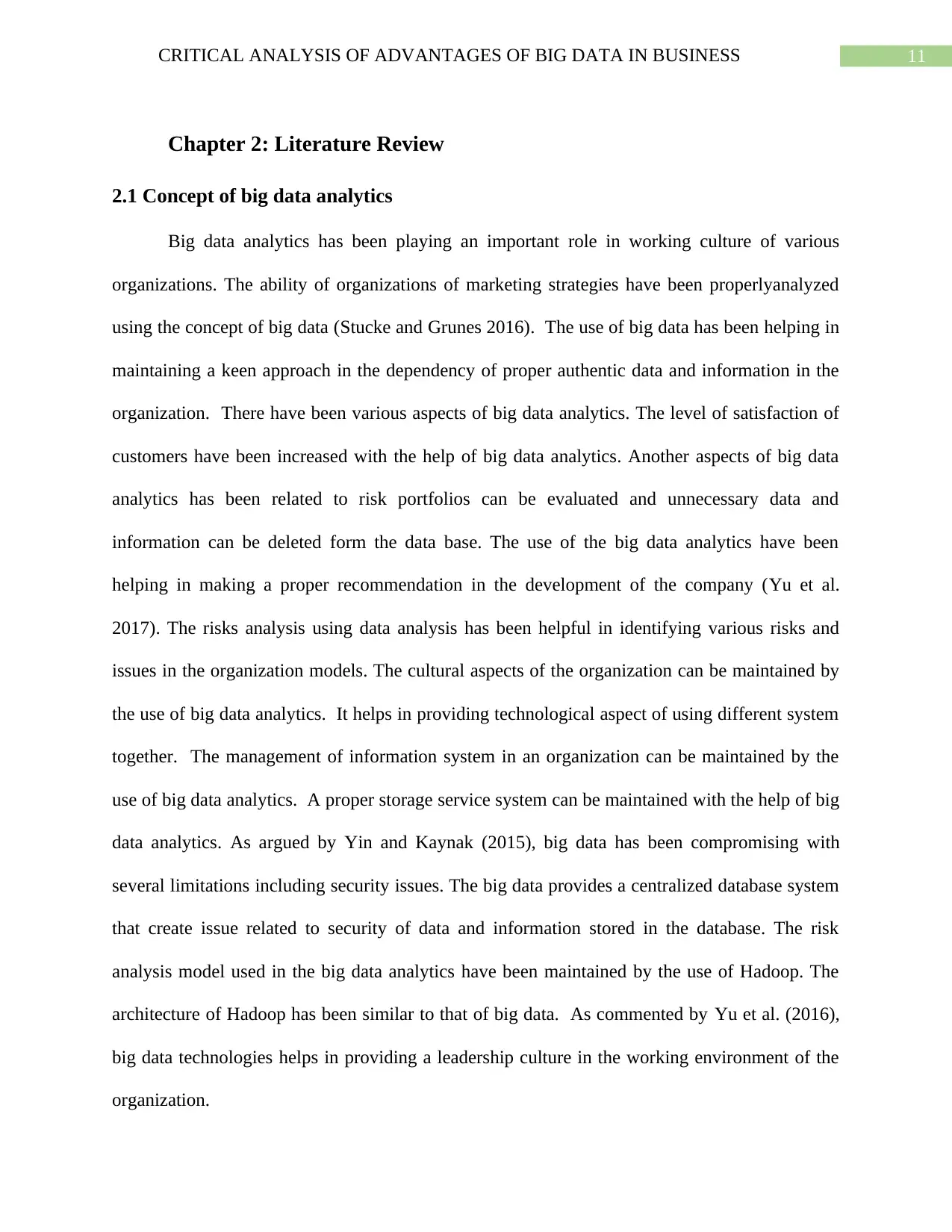
11CRITICAL ANALYSIS OF ADVANTAGES OF BIG DATA IN BUSINESS
Chapter 2: Literature Review
2.1 Concept of big data analytics
Big data analytics has been playing an important role in working culture of various
organizations. The ability of organizations of marketing strategies have been properlyanalyzed
using the concept of big data (Stucke and Grunes 2016). The use of big data has been helping in
maintaining a keen approach in the dependency of proper authentic data and information in the
organization. There have been various aspects of big data analytics. The level of satisfaction of
customers have been increased with the help of big data analytics. Another aspects of big data
analytics has been related to risk portfolios can be evaluated and unnecessary data and
information can be deleted form the data base. The use of the big data analytics have been
helping in making a proper recommendation in the development of the company (Yu et al.
2017). The risks analysis using data analysis has been helpful in identifying various risks and
issues in the organization models. The cultural aspects of the organization can be maintained by
the use of big data analytics. It helps in providing technological aspect of using different system
together. The management of information system in an organization can be maintained by the
use of big data analytics. A proper storage service system can be maintained with the help of big
data analytics. As argued by Yin and Kaynak (2015), big data has been compromising with
several limitations including security issues. The big data provides a centralized database system
that create issue related to security of data and information stored in the database. The risk
analysis model used in the big data analytics have been maintained by the use of Hadoop. The
architecture of Hadoop has been similar to that of big data. As commented by Yu et al. (2016),
big data technologies helps in providing a leadership culture in the working environment of the
organization.
Chapter 2: Literature Review
2.1 Concept of big data analytics
Big data analytics has been playing an important role in working culture of various
organizations. The ability of organizations of marketing strategies have been properlyanalyzed
using the concept of big data (Stucke and Grunes 2016). The use of big data has been helping in
maintaining a keen approach in the dependency of proper authentic data and information in the
organization. There have been various aspects of big data analytics. The level of satisfaction of
customers have been increased with the help of big data analytics. Another aspects of big data
analytics has been related to risk portfolios can be evaluated and unnecessary data and
information can be deleted form the data base. The use of the big data analytics have been
helping in making a proper recommendation in the development of the company (Yu et al.
2017). The risks analysis using data analysis has been helpful in identifying various risks and
issues in the organization models. The cultural aspects of the organization can be maintained by
the use of big data analytics. It helps in providing technological aspect of using different system
together. The management of information system in an organization can be maintained by the
use of big data analytics. A proper storage service system can be maintained with the help of big
data analytics. As argued by Yin and Kaynak (2015), big data has been compromising with
several limitations including security issues. The big data provides a centralized database system
that create issue related to security of data and information stored in the database. The risk
analysis model used in the big data analytics have been maintained by the use of Hadoop. The
architecture of Hadoop has been similar to that of big data. As commented by Yu et al. (2016),
big data technologies helps in providing a leadership culture in the working environment of the
organization.
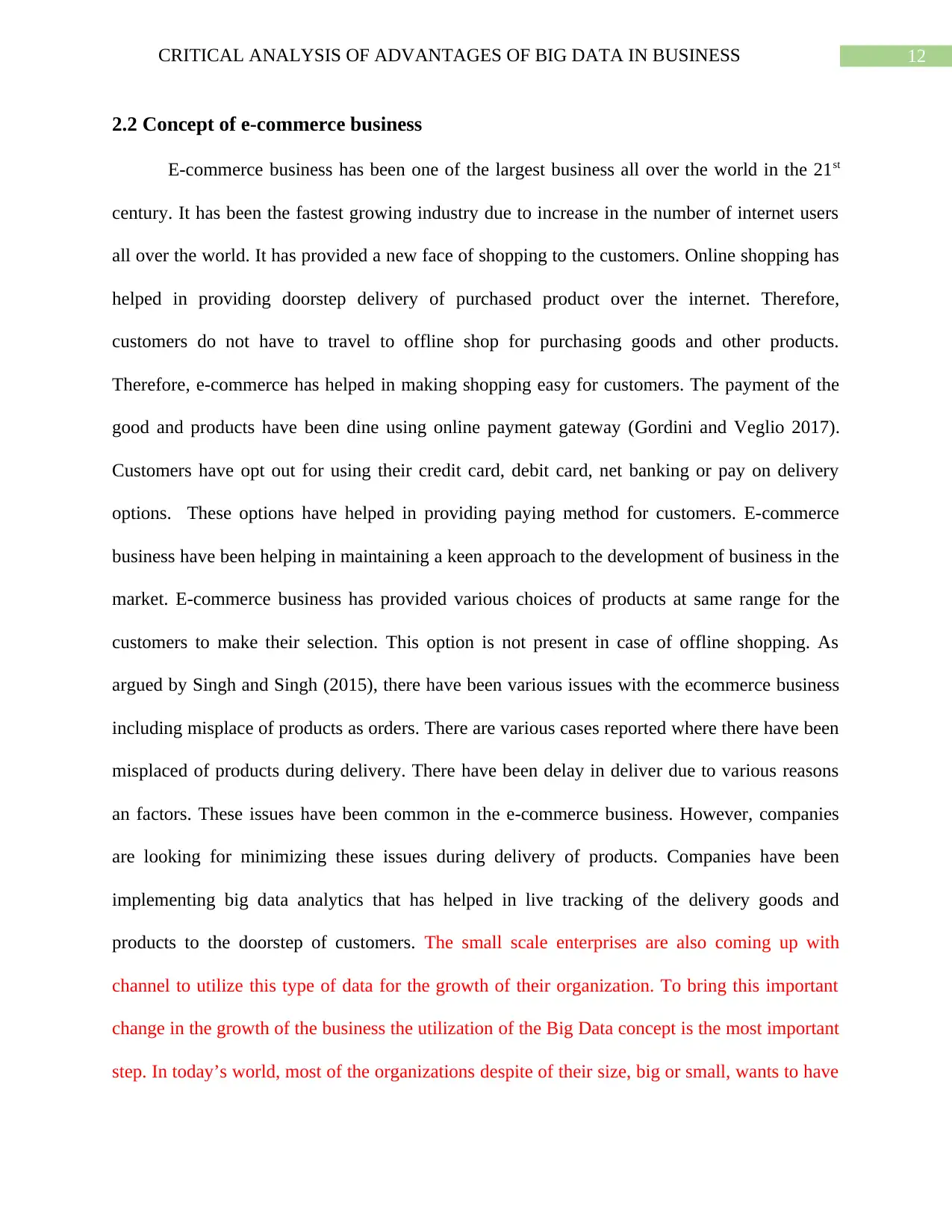
12CRITICAL ANALYSIS OF ADVANTAGES OF BIG DATA IN BUSINESS
2.2 Concept of e-commerce business
E-commerce business has been one of the largest business all over the world in the 21st
century. It has been the fastest growing industry due to increase in the number of internet users
all over the world. It has provided a new face of shopping to the customers. Online shopping has
helped in providing doorstep delivery of purchased product over the internet. Therefore,
customers do not have to travel to offline shop for purchasing goods and other products.
Therefore, e-commerce has helped in making shopping easy for customers. The payment of the
good and products have been dine using online payment gateway (Gordini and Veglio 2017).
Customers have opt out for using their credit card, debit card, net banking or pay on delivery
options. These options have helped in providing paying method for customers. E-commerce
business have been helping in maintaining a keen approach to the development of business in the
market. E-commerce business has provided various choices of products at same range for the
customers to make their selection. This option is not present in case of offline shopping. As
argued by Singh and Singh (2015), there have been various issues with the ecommerce business
including misplace of products as orders. There are various cases reported where there have been
misplaced of products during delivery. There have been delay in deliver due to various reasons
an factors. These issues have been common in the e-commerce business. However, companies
are looking for minimizing these issues during delivery of products. Companies have been
implementing big data analytics that has helped in live tracking of the delivery goods and
products to the doorstep of customers. The small scale enterprises are also coming up with
channel to utilize this type of data for the growth of their organization. To bring this important
change in the growth of the business the utilization of the Big Data concept is the most important
step. In today’s world, most of the organizations despite of their size, big or small, wants to have
2.2 Concept of e-commerce business
E-commerce business has been one of the largest business all over the world in the 21st
century. It has been the fastest growing industry due to increase in the number of internet users
all over the world. It has provided a new face of shopping to the customers. Online shopping has
helped in providing doorstep delivery of purchased product over the internet. Therefore,
customers do not have to travel to offline shop for purchasing goods and other products.
Therefore, e-commerce has helped in making shopping easy for customers. The payment of the
good and products have been dine using online payment gateway (Gordini and Veglio 2017).
Customers have opt out for using their credit card, debit card, net banking or pay on delivery
options. These options have helped in providing paying method for customers. E-commerce
business have been helping in maintaining a keen approach to the development of business in the
market. E-commerce business has provided various choices of products at same range for the
customers to make their selection. This option is not present in case of offline shopping. As
argued by Singh and Singh (2015), there have been various issues with the ecommerce business
including misplace of products as orders. There are various cases reported where there have been
misplaced of products during delivery. There have been delay in deliver due to various reasons
an factors. These issues have been common in the e-commerce business. However, companies
are looking for minimizing these issues during delivery of products. Companies have been
implementing big data analytics that has helped in live tracking of the delivery goods and
products to the doorstep of customers. The small scale enterprises are also coming up with
channel to utilize this type of data for the growth of their organization. To bring this important
change in the growth of the business the utilization of the Big Data concept is the most important
step. In today’s world, most of the organizations despite of their size, big or small, wants to have
⊘ This is a preview!⊘
Do you want full access?
Subscribe today to unlock all pages.

Trusted by 1+ million students worldwide
1 out of 46
Related Documents
Your All-in-One AI-Powered Toolkit for Academic Success.
+13062052269
info@desklib.com
Available 24*7 on WhatsApp / Email
![[object Object]](/_next/static/media/star-bottom.7253800d.svg)
Unlock your academic potential
Copyright © 2020–2025 A2Z Services. All Rights Reserved. Developed and managed by ZUCOL.





